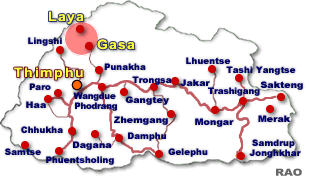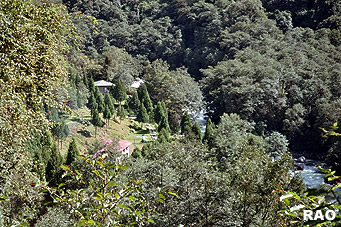|
The
healing waters of Gasa - Gasa Hot Springs
|
 |
Bhutan Tourism |
 |
Bhutan Information |
|
|
 |
|
Gasa
Tshachhu - Only a four-hour trek
|

|
 |
| The
healing waters of the famous Gasa Tshachhu (hot springs) is only a four-hour
walk with the motor road having reached Goen Damje.
"The
number of people visiting the Tshachhu is increasing," said Tsechu, a shopkeeper
in the vicinity of the hot springs |
|
The
coming of electricity on May 8 this month has made soaking in the waters
all the more convenient. "People used candles and kerosene lamps before,
but now, more people have started using the Tshachhu at night," said Dago,
the caretaker of the Tshachhu.
Soaking
in the Tshachhu is believed to help people suffering from sinusitis, rheumatism,
arthritis, ulcers, indigestion, skin diseases, sexually transmitted infections,
tuberculosis and even paralysis.
 |
| While
there is no scientific evidence of its curative powers most visitors say
that it yields positive results. It is believed that the results are better
if one visited the Tshachhu for three consecutive years.
Sangay,
36, from Thimphu first visited the Tshachhu in 2003 hoping to cure his sinusitis
which western medicine had failed to provide any relief. On his fourth
year to the Tshachhu, Sangay does not take any medicines today. He believes
his illness was cured by the hot spring. |
|
Besides
visitors from Paro, Chapcha and Haa, people from as far as Singye Dzong
also visit the Tshachhu," said caretaker Dago. Most visitors stay for about
11 days.In
the past, the motor road from Punakha ended at Tashuthang and the walk
to the Tshachhu took two whole days.
The
road is expected to reach Zameyzam at the foot of the Gasa ridge on which
the Gasa Dzong stands in the next two years, which would reduce the walk
to the Tshachhu to half an hour.
In
anticipation of an increase in visitors in the future the dzongkhag administration
has started building a suspension bridge across the Mochu so that visitors
to the Tshachhu can pitch tents on the other side of the river. As of now,
visitors pitch tents near the Tshachhu and during peak season, in winter
and spring, the area near the Tshachhu is crammed.
Anim
Ugyen Choden, 64, said that when she visited the Tshachhu for the
first time 50 years ago she walked for four days from Wangduephodrang.
"There
was a large single natural pool which was divided into four smaller pools
by wooden fences," said Aum Ugyen Choden. "People used to take bath and
wash clothes inside the pool but now, it is far cleaner."
Today,
the four pools have concrete walls, roofs and a well-maintained drainage
system. Each pool is believed to have specific curative powers.
According
to residents, apart from the Gasa Tshachhu, there are about 108 menchus
(medicinal waters) in Gasa dzongkhag. The Jage Menchu helps cure dry
cough and asthma and the Zamae Menchu relieves joint pains.
| Contributed
by Kesang Dema, KUENSEL, Bhutan's
National Newspaper |
 |
| Information on Bhutan |
 |
|




